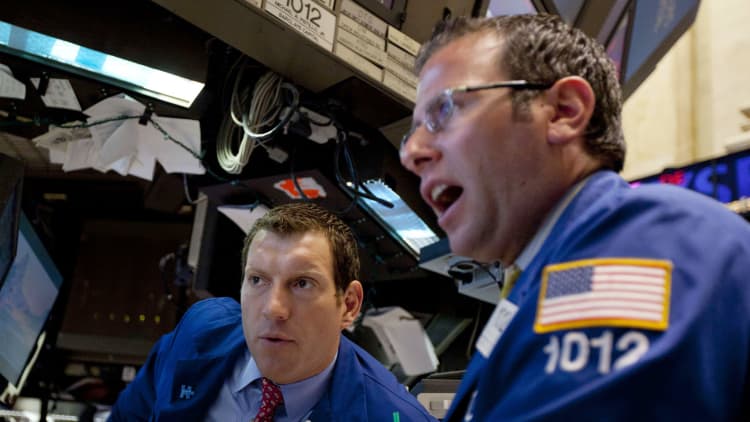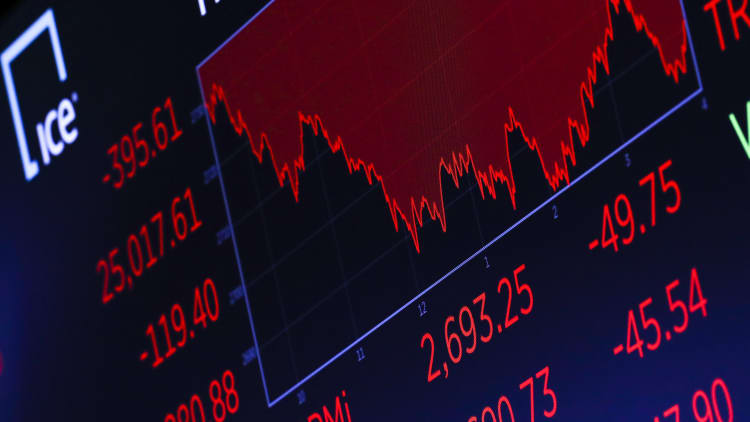
Popular culture focuses on the stock market, but Wall Street keeps its eyes on bonds.
Bond trading has created big fortunes for some of finance's most colorful personalities, and it has brought down Nobel Prize-winning economists who got stuck on the wrong side of a trade.
But bonds are also important to Wall Street for their predictive qualities. Analysts pay an enormous amount of attention to U.S. government bonds, specifically to the difference in their interest rates. They compare the rate on the 2-year Treasury, for example, to that of the benchmark 10-year Treasury.

The analysts plot out these rates on a spectrum and watch them move around. Then they use this data to predict where the economy and stock and bond markets are headed.
Volatile oil prices, trade tensions, political uncertainty — all of it gets reflected in the bond market. And there's a lot of talk these days about a coma-inducing term Wall Street gives this spectrum: the yield curve.
Normally, the 10-year note would have a higher rate than the 2-year note. If you drew a line between them on a graph, it would be an upward sloping curve, starting with the 2-year on the left and moving to the 10-year on the right. The higher rate for the longer-term bond compensates an investor for the greater risk that inflation will chip away at the value of that investment over time.
Source: FactSet
Higher long-term rates reflect expectations that growth will continue. But when the difference between the short- and long-term rates narrows, it's a signal that people are less convinced growth is here to stay. The yield curve is a barometer of this sentiment.
Longer-term rates have been stubbornly low and slow to react to the Federal Reserve's efforts to push rates higher. Since the Fed's rate hikes have more immediate effect on the 2-year notes, this has created what some see as a worrisome dynamic in the market.
The dreaded 'inversion'
The rate on the 2-year note is inching closer to that of the 10-year, making that ordinarily upward sloping curve flatter. The 2-year rate is dangerously close to rising above the 10-year, in fact. That creates a topsy-turvy condition Wall Street analysts like to call "inversion," where the line of the slope shifts downward.
If the historic pattern holds, an inverted yield curve would mean recession is on the horizon. It won't be immediate, but recessions have followed inversions a few months to two years later several times over many decades.
"In a longer range chart going back to 1962, there has never been a recession that wasn't preceded by an inversion of the yield curve," explained Bespoke Investment Group in a note to clients earlier this year.
The rate on the 2-year has already jumped above the shorter-term 5-year note, a move that suggests the "economy is poised to weaken," DoubleLine Capital's Jeffrey Gundlach told Reuters in an interview on Tuesday. Gundlach, a noted bond investor, has been warning investors to be cautious.
Gundlach's comment and increased fears about an economic slowdown pushed the Dow Jones Industrial Average down as much as 600 points at midday on Tuesday.
Some traders are focused on what these shifts in the bond market signal for the stock market, which has been on a nine-year bull run. At times when the curve has inverted, the S&P 500 was down an average of 1.9 percent 12 months later.
Michael Darda, the chief economist at MKM Partners, says people may be too focused on the wrong data. "Recession forecasting is fraught with difficulty, so it's important that we don't make it more difficult than it has to be by focusing on the wrong indicators, or, at a minimum, less reliable ones," he said in a note Tuesday, pointing out that the difference between the 2- and 5-year rates are not reliable indicators.
It is the difference between the 10-year and the 1-year that everyone should worry about, he said, and that shows no inversion, yet.
Spark an equity rebound?
If rates merely narrow without inverting, the broad stock index has a chance of rising.
In the past when short-term rates narrowed the gap to within 50 percentage points (0.50), the S&P ended the next year up an average 3.2 percent, according to Bespoke research. When they narrowed to under 150 points, the S&P's average gain was 14.8 percent in the next 12 months.
Movements in bond rates can also be somewhat of a self-fulfilling prophesy. If people are worried an inversion will lead to losses in the stock market or that a recession is near, they may shift money into longer-term bonds. And since bond prices move in the opposite direction as rates, a lot of bond buying would push rates lower, flattening the yield curve.
"A key point to remember and one which we have pointed out over the years, though, is that flat yield curves by themselves are not a reliable predictor of recessions," Bespoke wrote in a note in May. "In order for the 'recession countdown' to start, the curve really has to invert."
WATCH: Here's what 13 experts are saying about the next recession


